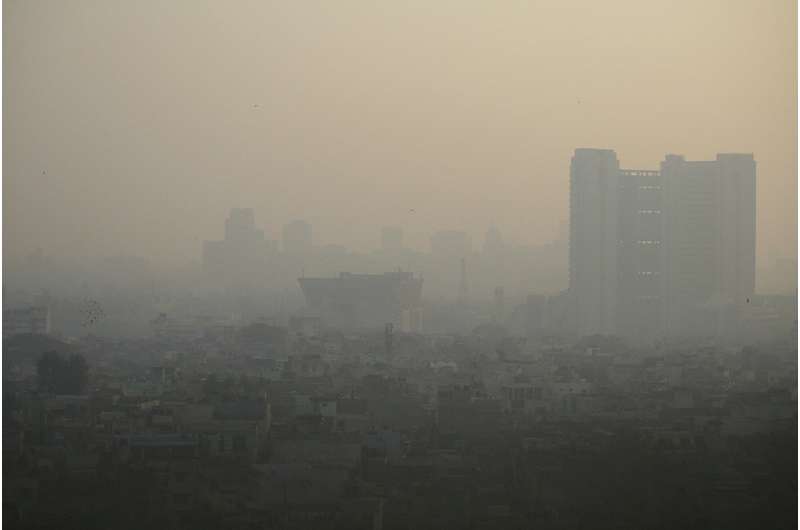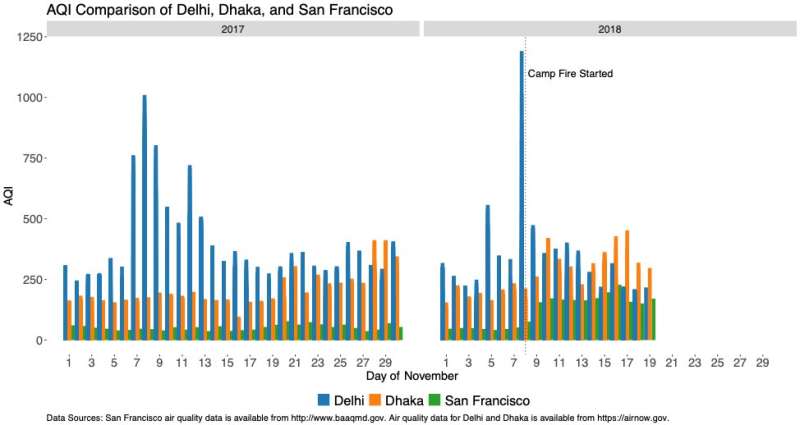Living with air pollution

People wearing smoke masks, children going stir-crazy indoors, families driving hours to find fresh air. Alarming as it is to some, unhealthy air enveloping the San Francisco Bay Area in recent days is all too familiar to millions of people around the world (see global ranking and air pollution map).
In fact, the air quality index (AQI) – a representation of pollutant concentration over a specified period of time – in San Francisco in recent days is on par with some of the most polluted cities in the world, according to Stanford researchers who study the effects of poor air quality.
"I don't want to minimize how devastating the California fires have been or the current unusual state of air quality in the Bay Area, but these conditions are really the norm for people living in many other parts of the world," said Nina Brooks, a doctoral candidate in the Emmett Interdisciplinary Program on Environment and Resources (E-IPER) in Stanford's School of Earth, Energy & Environmental Sciences.
Brooks does field work in Dhaka, Bangladesh, for a Stanford-led project to make brick manufacturing cleaner. While air pollution in Dhaka is high year-round, it spikes dramatically in winter months when coal-burning brick kilns around the city operate. The AQI in Dhaka during the winter, where more than 1,000 brick kilns operate, typically hovers above 150 – a level considered unhealthy for all groups – but often spikes much higher.
Globally, long-term exposure to outdoor air pollution is responsible for 4.2 million deaths, according to the World Health Organization, and 9 out of 10 people breathe outdoor and/or indoor air containing high levels of pollutants.

"The poor, young and elderly are most vulnerable," said Marshall Burke, an assistant professor of Earth system science in the School of Earth, Energy & Environmental Sciences. "Climate change can exacerbate the situation by driving meteorological conditions conducive to forming ozone and increasing the chance of wildfires, among other impacts."
Burke coauthored a study showing that exposure to particulate matter in sub-Saharan Africa led to 400,000 otherwise preventable infant deaths in a single year. By analyzing satellite measurements, Burke and his colleagues revealed that small improvements in air quality could be one of the most effective interventions to curb infant mortality rates in the region.
Children under age 5 in lower-income countries are more than 60 times as likely to die from exposure to air pollution as children in high-income countries, according to the World Bank. Regardless of age, people exposed to polluted air for long periods of time are more likely to suffer from diseases such as stroke, lung cancer and chronic obstructive pulmonary disease.
"It's important for us to think about our health here, but we should also think about how we can use our creativity and resources to help people around the world," said Alex Yu, a postdoctoral scholar in infectious disease who does research with Brooks in Bangladesh. "This is a big problem that is usually invisible to us. It's a fact of daily life in many places, and has a lot of health consequences."
Brooks compiled AQI data for Delhi, Dhaka and San Francisco that paint a stark picture. They show that air pollution in San Francisco spiked after the Camp Fire began on Nov. 8 and approached levels in Delhi and Dhaka. However, a comparison with previous weeks and the same month in 2017 show how much of an aberration poor air quality is in the Bay Area, while in cities such as Delhi and Dhaka it is just business as usual.
Provided by Stanford University




















